CHAPTER X, Part TWO.
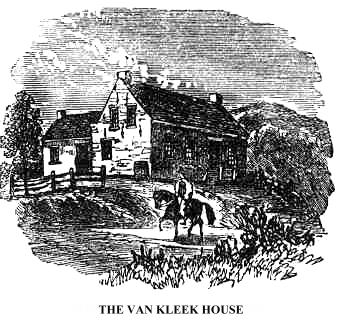 Poughkeepsie
was settled by the Dutch at the close of the seventeenth century. The first
substantial stone building was erected not far from the Winnakee, by Baltus
Van Kleek, in the year 1705, and remained a hundred and thirty years, when
it made way for modern improvements. This house, like many others built so
early, was pierced with loopholes for musketry, near the roof, that being
a necessary precaution against attacks by the Indians. It was the scene of
stirring events, being for many years a tavern, and the gathering place of
the people. When the old court-house was burned at the outbreak of the revolution,
it became the meeting place of the citizens for public purposes. There Ann
Lee, the founder of the Shaker church in America, was confined, in 1776, on
a charge of complicity with the enemies of republicanism. There the legislature
of New York, when driven by the torch from Kingston, in 1777, met, and continued
during two sessions; and there many of the members of the State Convention
in 1788, to consider the Federal Constitution, found a home during the session.
The city is partly upon a hill-side, sloping to the river, but chiefly upon
an elevated plain, back of which is College Hill, whose summit is five hundred
feet above the town. It is crowned with an edifice modeled, externally, after
the Temple of Minerva, at Athens, and devoted to the use of a popular institution
of learning. The views from this summit are extensive, and very interesting,
and embrace a region about twenty-five hundred square miles in extent of the
most diversified scenery. The city, appearing like a town in a forest, lies
at the foot of the spectator, and between the lofty Katzbergs on the north,
and the Highlands on the south, the Hudson is seen at intervals, having the
appearance of a chain of little lakes. Around, within an area of twenty to
thirty miles in diameter, spreads out a farming country, like a charming picture,
beautiful in every feature.
Poughkeepsie
was settled by the Dutch at the close of the seventeenth century. The first
substantial stone building was erected not far from the Winnakee, by Baltus
Van Kleek, in the year 1705, and remained a hundred and thirty years, when
it made way for modern improvements. This house, like many others built so
early, was pierced with loopholes for musketry, near the roof, that being
a necessary precaution against attacks by the Indians. It was the scene of
stirring events, being for many years a tavern, and the gathering place of
the people. When the old court-house was burned at the outbreak of the revolution,
it became the meeting place of the citizens for public purposes. There Ann
Lee, the founder of the Shaker church in America, was confined, in 1776, on
a charge of complicity with the enemies of republicanism. There the legislature
of New York, when driven by the torch from Kingston, in 1777, met, and continued
during two sessions; and there many of the members of the State Convention
in 1788, to consider the Federal Constitution, found a home during the session.
The city is partly upon a hill-side, sloping to the river, but chiefly upon
an elevated plain, back of which is College Hill, whose summit is five hundred
feet above the town. It is crowned with an edifice modeled, externally, after
the Temple of Minerva, at Athens, and devoted to the use of a popular institution
of learning. The views from this summit are extensive, and very interesting,
and embrace a region about twenty-five hundred square miles in extent of the
most diversified scenery. The city, appearing like a town in a forest, lies
at the foot of the spectator, and between the lofty Katzbergs on the north,
and the Highlands on the south, the Hudson is seen at intervals, having the
appearance of a chain of little lakes. Around, within an area of twenty to
thirty miles in diameter, spreads out a farming country, like a charming picture,
beautiful in every feature.
The general appearance of Poughkeepsie from the hills above
Lewisburg, on the western side of the 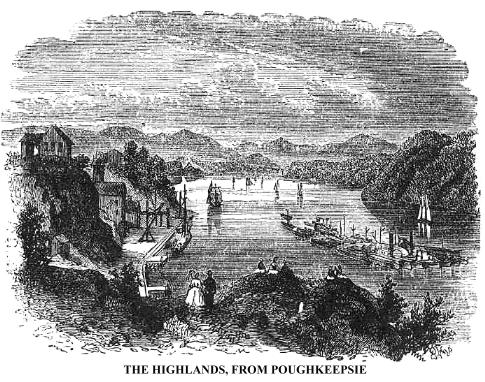 Hudson,
is given in our sketch. It is one of the most delightful places for residence
in the United States. It is centrally situated between New York the commercial,
and Albany the political, capital of the State. Its streets are shaded with
maple, elm, and acacia trees, and their cleanliness is proverbial. It is celebrated
for its numerous seminaries of learning for both sexes, the salubrity of its
climate, the fertility of the surrounding country, and the wealth and general
independence of its inhabitants. The eye and ear are rarely offended by public
exhibitions of squalor or vice, while evidences of thrift are seen on every
hand.
Hudson,
is given in our sketch. It is one of the most delightful places for residence
in the United States. It is centrally situated between New York the commercial,
and Albany the political, capital of the State. Its streets are shaded with
maple, elm, and acacia trees, and their cleanliness is proverbial. It is celebrated
for its numerous seminaries of learning for both sexes, the salubrity of its
climate, the fertility of the surrounding country, and the wealth and general
independence of its inhabitants. The eye and ear are rarely offended by public
exhibitions of squalor or vice, while evidences of thrift are seen on every
hand.
From a high rocky bluff on the river front of Poughkeepsie, named the Call Rock, exquisite views of the Hudson, north and south, may be obtained. The scene southward, which includes a distant view of the Highlands, is the most attractive. At all times the river is filled with water-craft of almost every description. The most striking objects on its surface are fleets of barges from the northern and western canals, loaded with the products of the fields and forests, lashed or tethered together, and towed by a steamboat. On these barges whole families sometimes reside during the season of navigation; and upon lines stretched over piles of lumber, newly-washed clothes may be frequently seen fluttering in the breeze. One of these fleets appears in our sketch.
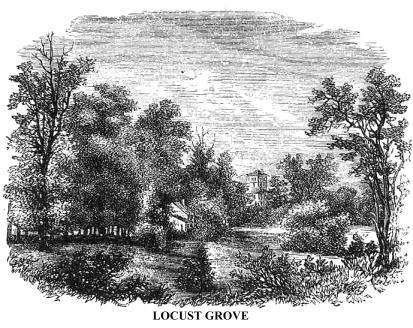 Two
miles below Poughkeepsie is Locust Grove, the seat of Professor Samuel F.B.
Morse, an eminent artist and philosopher, the founder of the American Academy
of Design, but better known to the world as the author of the system of telegraphing
by electro-magnetism, now used in almost every civilized country on the globe.
For this wonderful contribution to science and addition to the world's inventions
for moral and material advancement, he has been honored by several royal testimonials,
honorary and substantial, and by the universal gratitude and admiration of
his countrymen. Locust Grove is his summer retreat, and from his study he
has electrographic communication with all parts of the United States and the
British provinces. The mansion is so embowered that it is almost invisible
to the traveler on the highway. But immediately around it are gardens, conservatories,
and a pleasant lawn, basking in the sunshine, and through vistas between magnificent
trees, glimpses may be caught of the Hudson, the northern and southern ranges
of mountains, and villages that dot the western shore of the river. Here the
master dispenses a generous hospitality to friends and strangers, and with
the winning graces of a modest, unobtrusive nature, he delights all who enter
the charmed circle of Locust Grove. For the man of taste and genius his home
is one of the most charming retreats to be found on the banks of the Hudson
from the wilderness to the sea.
Two
miles below Poughkeepsie is Locust Grove, the seat of Professor Samuel F.B.
Morse, an eminent artist and philosopher, the founder of the American Academy
of Design, but better known to the world as the author of the system of telegraphing
by electro-magnetism, now used in almost every civilized country on the globe.
For this wonderful contribution to science and addition to the world's inventions
for moral and material advancement, he has been honored by several royal testimonials,
honorary and substantial, and by the universal gratitude and admiration of
his countrymen. Locust Grove is his summer retreat, and from his study he
has electrographic communication with all parts of the United States and the
British provinces. The mansion is so embowered that it is almost invisible
to the traveler on the highway. But immediately around it are gardens, conservatories,
and a pleasant lawn, basking in the sunshine, and through vistas between magnificent
trees, glimpses may be caught of the Hudson, the northern and southern ranges
of mountains, and villages that dot the western shore of the river. Here the
master dispenses a generous hospitality to friends and strangers, and with
the winning graces of a modest, unobtrusive nature, he delights all who enter
the charmed circle of Locust Grove. For the man of taste and genius his home
is one of the most charming retreats to be found on the banks of the Hudson
from the wilderness to the sea.
About four miles below Poughkeepsie is an ancient stone farm-house
and a mill, at the mouth of Spring 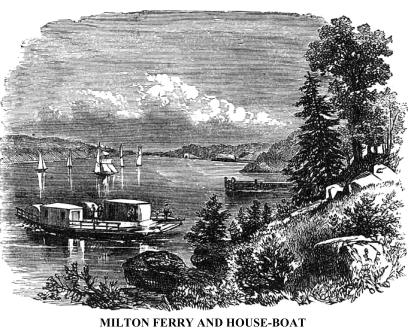 Brook,
at the eastern terminus of the Milton Ferry. Here, during the old war for
independence, lived Theophilus Anthony, a blacksmith, farmer, miller, and
staunch Whig, who used his forge for most rebellious purposes. He assisted
in making a great chain (of which I shall hereafter write), that was stretched
across the Hudson in the Highlands at Fort Montgomery, to prevent the British
ships of war ascending the river and carrying invading troops into the heart
of the country. For this offence, when the chain and accompanying boom were
forced, and the vessels of Vaughan carried the firebrand to Esopus or Kingston,
the rebel blacksmith's mill was laid in ashes, and he was confined in the
loathsome Jersey prison-ship at New York, where he had ample time for reflection
and penitence for three weary years. Alas! the latter never came. He was a
sinner against ministers, too hardened for repentance, and he remained a rebel
until the close of his life. Another mill soon arose from the ashes of the
old one, and there his grandsons, the Messrs. Gill were grinding wheat when
we were there for the descendants of both Whigs and Tories, and never inquired
into the politics of the passengers upon their boat at the Milton Ferry. That
boat was keeping alive the memory of times before steam was used for navigation.
It was one of only two vessels of the kind upon the Hudson in 1860, that were
propelled by horse-power. The other was at Coxsakie. The Milton ferry-boat
has since been withdrawn.
Brook,
at the eastern terminus of the Milton Ferry. Here, during the old war for
independence, lived Theophilus Anthony, a blacksmith, farmer, miller, and
staunch Whig, who used his forge for most rebellious purposes. He assisted
in making a great chain (of which I shall hereafter write), that was stretched
across the Hudson in the Highlands at Fort Montgomery, to prevent the British
ships of war ascending the river and carrying invading troops into the heart
of the country. For this offence, when the chain and accompanying boom were
forced, and the vessels of Vaughan carried the firebrand to Esopus or Kingston,
the rebel blacksmith's mill was laid in ashes, and he was confined in the
loathsome Jersey prison-ship at New York, where he had ample time for reflection
and penitence for three weary years. Alas! the latter never came. He was a
sinner against ministers, too hardened for repentance, and he remained a rebel
until the close of his life. Another mill soon arose from the ashes of the
old one, and there his grandsons, the Messrs. Gill were grinding wheat when
we were there for the descendants of both Whigs and Tories, and never inquired
into the politics of the passengers upon their boat at the Milton Ferry. That
boat was keeping alive the memory of times before steam was used for navigation.
It was one of only two vessels of the kind upon the Hudson in 1860, that were
propelled by horse-power. The other was at Coxsakie. The Milton ferry-boat
has since been withdrawn.
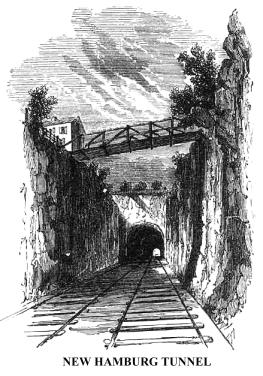 Opposite
Spring Brook is the village of Milton, remarkable, like its sister, Marlborough,
a few miles below, for the picturesque beauty of the surrounding country and
the abundance of Antwerp raspberries produced in its vicinity every year.
There and at some places on the eastern shore, are the chief sources of the
supply of that delicious fruit for the city of New York; and the quantity
raised is so great, that a small steamboat is employed for the sole purpose
of carrying raspberries daily to the city. These villages are upon high banks,
and are scarcely visible from the river. They have a background of rich farming
lands, terminating beyond a sweet valley by a range of lofty hills that are
covered with the primeval forest. They are the resort of New Yorkers during
the heat of summer.
Opposite
Spring Brook is the village of Milton, remarkable, like its sister, Marlborough,
a few miles below, for the picturesque beauty of the surrounding country and
the abundance of Antwerp raspberries produced in its vicinity every year.
There and at some places on the eastern shore, are the chief sources of the
supply of that delicious fruit for the city of New York; and the quantity
raised is so great, that a small steamboat is employed for the sole purpose
of carrying raspberries daily to the city. These villages are upon high banks,
and are scarcely visible from the river. They have a background of rich farming
lands, terminating beyond a sweet valley by a range of lofty hills that are
covered with the primeval forest. They are the resort of New Yorkers during
the heat of summer.
Eight miles below Poughkeepsie is the little village of New
Hamburg, situated at the foot of a rocky promontory thickly covered with the
Arbor Vitæ, or white cedar, and near the mouth of the Wappingi's Creek.
Through this bluff the Hudson River Railway passes in a tunnel 800 feet in
length, and then crosses the mouth of the Wappingi, upon a causeway and drawbridge.
All over this rocky bluff, including the roof of the tunnel, the Arbor Vitæ
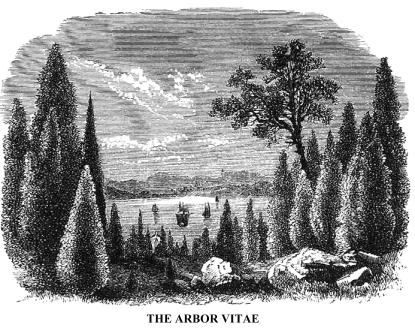 shrubs
stand thickly; and present, according to London, the eminent English writer
on horticulture and kindred subjects, some of the finest specimens of that
tree to be found in the world. Here they may be seen of all sizes and most
perfect forms, from the tiny shrub to the tall tree that shows its stem for
several feet from the ground. The most beautiful are those of six to ten feet
in height, whose branches shoot out close to the ground, forming perfect cones,
and exhibiting nothing to the eye but delicate sprays and bright green leaves.
When quite small these shrubs may be successfully transplanted; but under
cultivation they sometimes lose their perfect form, and become irregular,
like the common cedar tree. They are beginning to be extensively used for
hedges, and the ornamentation of pleasure grounds.*
shrubs
stand thickly; and present, according to London, the eminent English writer
on horticulture and kindred subjects, some of the finest specimens of that
tree to be found in the world. Here they may be seen of all sizes and most
perfect forms, from the tiny shrub to the tall tree that shows its stem for
several feet from the ground. The most beautiful are those of six to ten feet
in height, whose branches shoot out close to the ground, forming perfect cones,
and exhibiting nothing to the eye but delicate sprays and bright green leaves.
When quite small these shrubs may be successfully transplanted; but under
cultivation they sometimes lose their perfect form, and become irregular,
like the common cedar tree. They are beginning to be extensively used for
hedges, and the ornamentation of pleasure grounds.*
* The Arbor Vitae is the Thuya (can't read print) Occidentalis of Linnaeus. It is not the genuine white cedar, although it frequently bears that name. In New England it is often called Hackmatack. Its leaves lie in flattened masses along the stems, and each is filled with a vesicle containing a thin aromatic turpentine. It bears yellowish brown cones, about five lines in length.
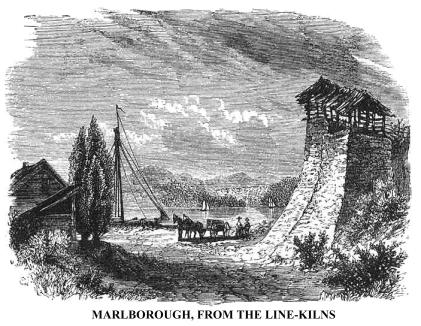 A
pleasant glimpse of Marlborough, through a broad ravine, may be obtained from
the rough eminence above the New Hamburg tunnel, and also from the lime-kilns
at the foot of the bluff, on the edge of the river, where a ferry connects
the two villages. But one of the most interesting views on the Hudson, in
this vicinity, is from the gravelly promontory near the town, at the mouth
of the Wappingi's Creek--a large stream that comes down from the hills in
the north-eastern part of Duchess County, dispensing fertility and extensive
water-power along its whole course. It is navigable for a mile and a half
from its mouth, when it falls seventy five feet, and furnishes power used
by quite a large manufacturing village. It is usually incorrectly spelled
Wappingers. Its name is derived from the Wappingi tribe of Indians, who, with
the Matteawans, inhabited this beautiful region on the Hudson, just north
of the Highlands. It should be written Wappingi's Creek.
A
pleasant glimpse of Marlborough, through a broad ravine, may be obtained from
the rough eminence above the New Hamburg tunnel, and also from the lime-kilns
at the foot of the bluff, on the edge of the river, where a ferry connects
the two villages. But one of the most interesting views on the Hudson, in
this vicinity, is from the gravelly promontory near the town, at the mouth
of the Wappingi's Creek--a large stream that comes down from the hills in
the north-eastern part of Duchess County, dispensing fertility and extensive
water-power along its whole course. It is navigable for a mile and a half
from its mouth, when it falls seventy five feet, and furnishes power used
by quite a large manufacturing village. It is usually incorrectly spelled
Wappingers. Its name is derived from the Wappingi tribe of Indians, who, with
the Matteawans, inhabited this beautiful region on the Hudson, just north
of the Highlands. It should be written Wappingi's Creek.
From the gravelly height the Highlands, the village of Newburgh,
and a large portion of the lower part of 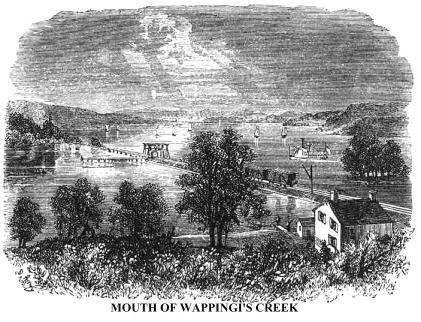 the
"Long Reach" from Newburgh to Crom Elbow, are seen; with the flat
rock in the river, at the head of Newburgh Bay and near its western shore,
known as Den Duyvel's Dans Kamer, or the Devil's Dance Chamber. This
rock has a level surface of about half an acre (now covered with beautiful
Arbor Vitæ shrubs), and is separated from the main-land by a marsh.
On this rock the Indians performed their peculiar semi-religious rites, called
pow-wows, before going upon hunting and fishing expeditions, or the
war-path. They painted themselves grotesquely, built a large fire upon this
rock, and danced around it with songs and yells, making strange contortions
of face and limbs, under the direction of their conjurors or "medicine
men." They would tumble, leap, run, and yell, when, as they said, the
Devil, or Evil Spirit, would appear in the shape of a beast of prey, or a
harmless animal; the former apparition betokened evil to their proposed undertaking,
and the latter prophesied of good. For at least a century after the Europeans
discovered the river, these hideous rites were performed upon this spot, and
the Dutch skippers who navigated the Hudson, called the rock Den Duyvel's
Dans Kamer. Here it was that Peter Stuyvesant's crew were "most
horribly frightened by roistering devils," according to the veracious
Knickerbocker.
the
"Long Reach" from Newburgh to Crom Elbow, are seen; with the flat
rock in the river, at the head of Newburgh Bay and near its western shore,
known as Den Duyvel's Dans Kamer, or the Devil's Dance Chamber. This
rock has a level surface of about half an acre (now covered with beautiful
Arbor Vitæ shrubs), and is separated from the main-land by a marsh.
On this rock the Indians performed their peculiar semi-religious rites, called
pow-wows, before going upon hunting and fishing expeditions, or the
war-path. They painted themselves grotesquely, built a large fire upon this
rock, and danced around it with songs and yells, making strange contortions
of face and limbs, under the direction of their conjurors or "medicine
men." They would tumble, leap, run, and yell, when, as they said, the
Devil, or Evil Spirit, would appear in the shape of a beast of prey, or a
harmless animal; the former apparition betokened evil to their proposed undertaking,
and the latter prophesied of good. For at least a century after the Europeans
discovered the river, these hideous rites were performed upon this spot, and
the Dutch skippers who navigated the Hudson, called the rock Den Duyvel's
Dans Kamer. Here it was that Peter Stuyvesant's crew were "most
horribly frightened by roistering devils," according to the veracious
Knickerbocker.
Sixteen miles below Poughkeepsie, on the same side of the Hudson, is the small village of Fishkill Landing, having for a background, in a view of it from the river, the lofty range of the Fishkill Mountains, which form a portion of the Highlands proper, through which the Hudson flows a few miles below. Here is the Fishkill and Newburgh railway-station, and a long wharf that stretches over the shallow bed of the river to the deep channel far in the direction of Newburgh. That large town lies upon the steep slope on the western shore, and presents a beautiful appearance to the traveler by railway or steamboat, especially when it is lighted up by the morning sun. Around that old town, the site of the oldest permanent settlement in Orange Country, are clustered many associations of the war for independence; for near there the Continental Army was encamped; there it was disbanded; and in a house yet standing, and well preserved, Washington had his head-quarters for a long time, as we shall observe presently.
The first European settlement at Newburgh was commenced in 1709, by some Palatines, who went up from New York for the purpose, seated themselves a little above Quassaic (sometimes called Chambers') Creek, where the Quassaic Indians resided, and laid the foundations of "Newborough." They obtained a patent from Queen Anne in 1719, but becoming dissatisfied, they went some to Pennsylvania, and some to the Mohawk Valley. English, Irish, New England, and Huguenot settlers supplied their places. New Windsor (two miles below), and other places, were settled, and a flourishing little commonwealth was commenced. New Windsor, upon the shores of a sheltered bay near the mouth of the Quassaic, was, for some time, the rival of Newburgh. They were included in the "Highland Precinct" until 1763, when they were divided into separate municipalities, and so remained until organized into towns in 1788.
Copyright © 1998, -- 2004. Berry Enterprises. All rights reserved. All items on the site are copyrighted. While we welcome you to use the information provided on this web site by copying it, or downloading it; this information is copyrighted and not to be reproduced for distribution, sale, or profit.